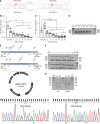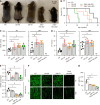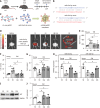miR-10a-5p and miR-10b-5p restore colonic motility in aged mice
- PMID: 40599192
- PMCID: PMC12207554
- DOI: 10.3748/wjg.v31.i24.104437
miR-10a-5p and miR-10b-5p restore colonic motility in aged mice
Abstract
Background: We previously identified miR-10b-5p as a key regulator of gastrointestinal (GI) motility through its essential role in the development and function of interstitial cells of Cajal (ICC), the pacemaker cells of the gut. Loss of miR-10b-5p in ICC impairs intestinal motility and contributes to constipation, a common condition in the elderly. Notably, miR-10b-5p is co-expressed with its paralog, miR-10a-5p, in ICC.
Aim: To investigate the roles of miR-10a-5p and miR-10b-5p in age-associated intestinal dysmotility and assess the therapeutic potential of restoring their expression.
Methods: We employed aged mice, mir-10a and mir-10b single and double knockout (KO) models, and human plasma and colon samples across age groups. GI and colonic transit, ICC network integrity, and expression levels of miR-10a/b-5p were evaluated. Additionally, we tested whether treatment with their microRNA mimics could restore GI motility in aged mice.
Results: Aged mice exhibited delayed GI and colonic transit, reduced fecal output, and diminished expression of miR-10a-5p and miR-10b-5p, which peaked during late embryonic and early postnatal stages and declined with age. This decline paralleled ICC network deterioration in the colon. All KO models exhibited impaired motility and ICC loss, with mir-10a KO mice displaying more severe phenotypes than mir-10b KO mice. Double KO mice demonstrated growth retardation and reduced survival, with homozygous mutants living only up to 3 months. Treatment of aged mice with miR-10a-5p and miR-10b-5p mimics encapsulated in jetPEI significantly improved GI and colonic motility. Successful delivery to the gut, including the colon, was confirmed. In human samples, both miR-10a/b-5p and KIT expression decreased with age.
Conclusion: miR-10a-5p and miR-10b-5p are essential for ICC maintenance and colonic motility, and their age-related decline contributes to GI dysmotility in both mice and humans. Restoring their levels offers a promising therapeutic strategy for treating age-related constipation and other motility disorders.
Keywords: Aged mice; Constipation; Gastrointestinal dysmotility; Interstitial cells of Cajal; MicroRNAs.
©The Author(s) 2025. Published by Baishideng Publishing Group Inc. All rights reserved.
Conflict of interest statement
Conflict-of-interest statement: This author discloses the following: Ro S and the University of Nevada Reno Office of Technology Transfer (serial No. 62/837,988, filed 24 April 2019) have published a PCT International Patent WO/2020/219872 entitled “Methods and compositions of miR-10 mimics and targets thereof”. Ro S is an employee and a member of the board of directors of RosVivo Therapeutics. Ha SE and Singh R are members of the board of directors of RosVivo Therapeutics. The remaining authors disclose no conflicts.
Figures





Similar articles
-
Zengye decoction regulated the expression of aquaporin in colon tissue of rats with constipation through miR-10a-5p targeting Drd2/AC/cAMP axis.Histol Histopathol. 2025 Jan 21:18876. doi: 10.14670/HH-18-876. Online ahead of print. Histol Histopathol. 2025. PMID: 39876776
-
miR-10b-5p Rescues Diabetes and Gastrointestinal Dysmotility.Gastroenterology. 2021 Apr;160(5):1662-1678.e18. doi: 10.1053/j.gastro.2020.12.062. Epub 2021 Jan 7. Gastroenterology. 2021. PMID: 33421511 Free PMC article.
-
Functional roles of interstitial cells of Cajal in the GI tract of rats.Am J Physiol Gastrointest Liver Physiol. 2025 Jun 1;328(6):G677-G695. doi: 10.1152/ajpgi.00036.2025. Epub 2025 Apr 15. Am J Physiol Gastrointest Liver Physiol. 2025. PMID: 40235202
-
Research progress on the regulation of interstitial cell of Cajal autophagy and apoptosis crosstalk by traditional Chinese medicine in gastrointestinal motility disorders.J Ethnopharmacol. 2025 Jul 24;351:120128. doi: 10.1016/j.jep.2025.120128. Epub 2025 Jun 11. J Ethnopharmacol. 2025. PMID: 40513924 Review.
-
Tegaserod for the treatment of irritable bowel syndrome and chronic constipation.Cochrane Database Syst Rev. 2007 Oct 17;(4):CD003960. doi: 10.1002/14651858.CD003960.pub3. Cochrane Database Syst Rev. 2007. PMID: 17943807
References
-
- Stillhart C, Asteriadis A, Bocharova E, Eksteen G, Harder F, Kusch J, Tzakri T, Augustijns P, Matthys C, Vertzoni M, Weitschies W, Reppas C. The impact of advanced age on gastrointestinal characteristics that are relevant to oral drug absorption: An AGePOP review. Eur J Pharm Sci. 2023;187:106452. - PubMed
-
- Huizinga JD, Hussain A, Chen JH. Interstitial cells of Cajal and human colon motility in health and disease. Am J Physiol Gastrointest Liver Physiol. 2021;321:G552–G575. - PubMed
MeSH terms
Substances
LinkOut - more resources
Full Text Sources
Medical
Research Materials

